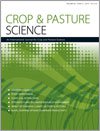Ver ítem
- xmlui.general.dspace_homeCentros e Institutos de InvestigaciónCIAP. Centro de Investigaciones AgropecuariasInstituto de Fisiología y Recursos Genéticos VegetalesArtículos científicosxmlui.ArtifactBrowser.ItemViewer.trail
- Inicio
- Centros e Institutos de Investigación
- CIAP. Centro de Investigaciones Agropecuarias
- Instituto de Fisiología y Recursos Genéticos Vegetales
- Artículos científicos
- Ver ítem
Identification of QTLs for shoot and root growth under ionic–osmotic stress in Lotus, using a RIL population
Resumen
The genus Lotus includes a group of forage legume species including genotypes of agronomic interest and model species. In this work, an experimental hydroponic growth system allowed the discrimination of growth responses to ionic–osmotic stress in a population of recombinant inbred lines (RILs) developed from L. japonicus × L. burttii and the identification of the associated quantitative trait loci (QTLs). The analyses led to the identification of eight
[ver mas...]
The genus Lotus includes a group of forage legume species including genotypes of agronomic interest and model species. In this work, an experimental hydroponic growth system allowed the discrimination of growth responses to ionic–osmotic stress in a population of recombinant inbred lines (RILs) developed from L. japonicus × L. burttii and the identification of the associated quantitative trait loci (QTLs). The analyses led to the identification of eight QTLs: three for shoot growth localised on chromosome 3, 5 and 6; one for root growth on chromosome 1; three for total growth on chromosome 1, 4 and 5; and one associated with shoot/root ratio on chromosome 3. An interaction of QTL × stress condition was established and the effect of the environment quantified. In summary, it was established that the allele from L. burttii explained most responses to osmotic stress, while the alleles of L. japonicus explained the responses related to ionic stress conditions. Of 49 markers linked to all QTLs identified, 41 expressed superiority of the L. burttii parental allele in the osmotic stress condition, but when an iso-osmotic concentration of NaCl was applied, L. burttii lost superiority in 21 of these markers. This shows the superiority of the L. japonicus parental allele in ionic stress conditions. This study is the first report in which a RIL population of lotus is analysed with the aim of providing molecular markers associated with plant responses to ionic or osmotic stress.
[Cerrar]

Autor
Quero, Gastón;
Gutíerrez, Lucía;
Lascano, Hernan Ramiro;
Monza, Jorge;
Sandal, Niels;
Borsani, Omar;
Fuente
Crop and Pasture Science 65 (2) : 139-149 (2014)
Fecha
2014-02-20
Editorial
CSIRO Publishing
ISSN
1836-0947
1836-5795 (online)
1836-5795 (online)
Formato
pdf
Tipo de documento
artículo
Palabras Claves
Derechos de acceso
Restringido
 Excepto donde se diga explicitamente, este item se publica bajo la siguiente descripción: Creative Commons Attribution-NonCommercial-ShareAlike 2.5 Unported (CC BY-NC-SA 2.5)
Excepto donde se diga explicitamente, este item se publica bajo la siguiente descripción: Creative Commons Attribution-NonCommercial-ShareAlike 2.5 Unported (CC BY-NC-SA 2.5)

